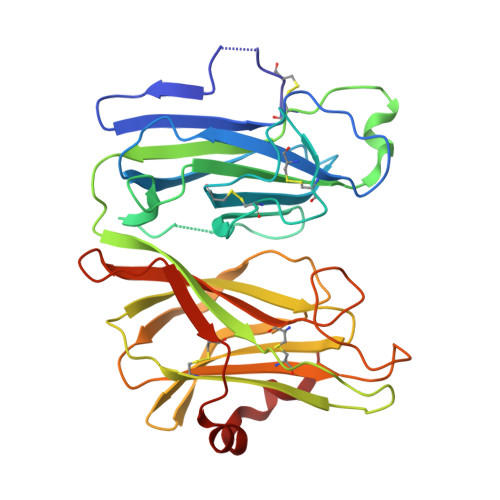New structures reveal flexible dynamics between the subdomains of peptidylglycine monooxygenase. Implications for an open to closed mechanism.
Arias, R.J., Welch, E.F., Blackburn, N.J.(2023) Protein Sci 32: e4615-e4615
- PubMed: 36880254
- DOI: https://doi.org/10.1002/pro.4615
- Primary Citation of Related Structures:
8DSJ, 8DSL, 8DSN - PubMed Abstract:
Peptidylglycine monooxygenase (PHM) is essential for the biosynthesis of many neuroendocrine peptides via a copper-dependent hydroxylation of a glycine-extended pro-peptide. The "canonical" mechanism requires the transfer of two electrons from one mononuclear copper (CuH, H-site) to a second mononuclear copper (CuM, M-site) which is the site of oxygen binding and catalysis. In most crystal structures the copper centers are separated by 11 Å of disordered solvent, but recent work has established that a PHM variant H108A forms a closed conformer in the presence of citrate with a reduced Cu-Cu site separation of ~4 Å. Here we report three new PHM structures where the H and M sites are separated by a longer distance of ~14 Å. Variation in Cu-Cu distance is the result of a rotation of the M subdomain about a hinge point centered on the pro 199 -leu 200 -ile 201 triad which forms the linker between subdomains. The energetic cost of domain dynamics is likely small enough to allow free rotation of the subdomains relative to each other, adding credence to recent suggestions that an open-to-closed transition to form a binuclear oxygen binding intermediate is an essential element of catalysis. This inference would explain many experimental observations that are inconsistent with the current canonical mechanism including substrate-induced oxygen activation and isotope scrambling during the peroxide shunt.
- Department of Chemical Physiology and Biochemistry, Oregon Health and Science University, Portland, Oregon, USA.
Organizational Affiliation:


















